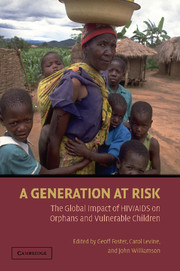Book contents
- Frontmatter
- Contents
- Foreword
- Preface
- Contributors
- Introduction: HIV/AIDS and Its Long-Term Impact on Children
- 1 Family and Community-Based Care for Children Affected by HIV/AIDS: Strengthening the Front Line Response
- 2 Strengthening Households and Communities: The Key to Reducing the Economic Impacts of HIV/AIDS on Children and Families
- 3 The Response of the Educational System to the Needs of Orphans and Children Affected by HIV/AIDS
- 4 Psychosocial Impact of the HIV/AIDS Epidemic on Children and Youth
- 5 Human Rights and Children Affected by HIV/AIDS
- 6 Religion and Responses to Orphans in Africa
- 7 Making the Right Choices in the Asia-Pacific Region: Protecting Children and Young People from HIV and Its Impacts
- 8 Troubled Tapestries: Children, Families, and the HIV/AIDS Epidemic in the United States
- 9 Interventions to Support Children Affected by HIV/AIDS: Priority Areas for Future Research
- 10 Finding a Way Forward: Reducing the Impacts of HIV/AIDS on Vulnerable Children and Families
- Chronology of Important Events
- Resource Guide
- Index
- References
4 - Psychosocial Impact of the HIV/AIDS Epidemic on Children and Youth
Published online by Cambridge University Press: 05 June 2012
- Frontmatter
- Contents
- Foreword
- Preface
- Contributors
- Introduction: HIV/AIDS and Its Long-Term Impact on Children
- 1 Family and Community-Based Care for Children Affected by HIV/AIDS: Strengthening the Front Line Response
- 2 Strengthening Households and Communities: The Key to Reducing the Economic Impacts of HIV/AIDS on Children and Families
- 3 The Response of the Educational System to the Needs of Orphans and Children Affected by HIV/AIDS
- 4 Psychosocial Impact of the HIV/AIDS Epidemic on Children and Youth
- 5 Human Rights and Children Affected by HIV/AIDS
- 6 Religion and Responses to Orphans in Africa
- 7 Making the Right Choices in the Asia-Pacific Region: Protecting Children and Young People from HIV and Its Impacts
- 8 Troubled Tapestries: Children, Families, and the HIV/AIDS Epidemic in the United States
- 9 Interventions to Support Children Affected by HIV/AIDS: Priority Areas for Future Research
- 10 Finding a Way Forward: Reducing the Impacts of HIV/AIDS on Vulnerable Children and Families
- Chronology of Important Events
- Resource Guide
- Index
- References
Summary
In this third decade of HIV/AIDS, the world community continues to stagger under the impacts of the pandemic, but no group carries a heavier burden than children. Worldwide, children affected by HIV/AIDS are disproportionately poor and malnourished. They are more likely to lack shelter, education, and health care. They are vulnerable to sexual abuse by adults. They are used for child labor in domestic or field work. In the developing world, as infants they may have acquired HIV infection from their mothers; if infected they typically die young, without access to life-prolonging treatment. In the United States and other developed countries, perinatal transmission has been dramatically reduced through the identification of HIV-infected pregnant women and administration of antiretrovirals during pregnancy and labor and after delivery.
Those who escape HIV infection, however, do not escape the impact of the disease. They may suffer the pain of the death of a parent. They may serve as caregivers to their ill parents – washing and feeding bedridden mothers or fathers – and often assume adult responsibilities for household maintenance. Older children may seek paid employment to support their family when no adult is well enough to work, and may raise their younger siblings in the place of their parents. When they are orphaned, they depend on the goodwill and resources of family, friends, or neighbors to take them in and care for them.
- Type
- Chapter
- Information
- A Generation at RiskThe Global Impact of HIV/AIDS on Orphans and Vulnerable Children, pp. 93 - 133Publisher: Cambridge University PressPrint publication year: 2005
References
- 8
- Cited by



